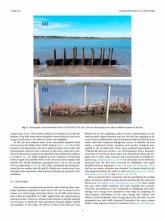
Abstract
Living shorelines are being widely implemented to mitigate shoreline erosion and provide ecosystem services, but how they interact with waves remains poorly understood. Wave transmission through living shoreline breakwalls is studied using field observations and theoretical approaches. The following hypotheses are tested: (i) living shoreline breakwalls can act as buffers against waves; (ii) wave transmission through these naturebased solutions is modulated by tides; and (iii) wave transmission through living shoreline breakwalls is similar to the behavior observed in waves through porous breakwaters. Observations were collected in intertidal settings where boat wakes and tides are the major flow components. Nearly 1000 boat wakes were identified in the observations using advanced time-frequency data analysis methods. Wave transmission through the breakwalls composed of tree branches was quantified and modulation of this process by tides was investigated. The two tested breakwall designs provided different behaviors of wave transmission. In the first design with an estimated porosity of 0.7 where the tree branches were bundled, transmission rates were found to vary mostly between 9% and 70% and had an average of 53%. Transmission increased with increasing water depth especially at mid-tide and low-tide where the height of the breakwall relative to depth was between 0.5 and 1. In the second design with an estimated porosity of 0.9 where the tree branches were not bundled, transmission rates exceeded 70% in 84% of the cases, sometimes reaching 100% transmission, and had an average of 83% with much less variability with depth compared to the first design. Wave transmission estimates based on theory of porous media were found to be most sensitive to breakwall porosity and the friction coefficient. Best agreement between the observed and theoretical estimates of wave transmission was found using a turbulent friction coefficient of 2.7, the median value of the most common range given in the literature on waves through porous media. The highest discrepancy between observed and theoretical estimates of wave transmission occurs at shallow depths when the breakwall emerged. In these conditions, the theory overestimates transmitted wave energy, most likely due to significant wave breaking and bottom friction in shallow water. The findings support our hypotheses that well-engineered semi-porous living shorelines act as buffers against human-mediated boat traffic and waves, and their related performance in dissipating wave energy and sustaining coastal ecosystems is modulated by depth. The results can be used as guidelines for design of living shorelines for given wave climate and breakwall properties.
About this resource
This article, published in the journal Continental Shelf Research, summarizes results from an experimental living shoreline installation at GTM Reserve in northeast Florida. This paper offers specific findings about how well the installations dampened boat wakes and protected shoreline marshes. The article is available from the journal website or a PDF copy can be requested by emailing: [email protected].
Safak, I, C. Angelini, P.L. Norby, N. Dix, A. Roddenberry, D. Herbert, E. Astrom, and A. Sheremet. 2020. Wave transmission through living shoreline breakwalls. Continental Shelf Research 211(104268). Available at: https://doi.org/10.1016/j.csr.2020.104268